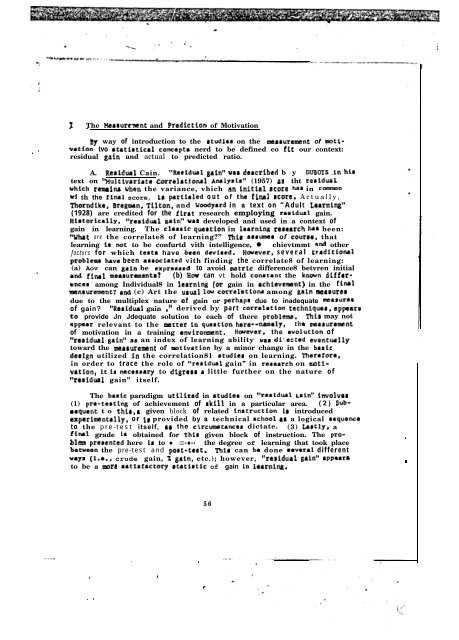Technical Report - International Military Testing Association
Technical Report - International Military Testing Association
Technical Report - International Military Testing Association
Create successful ePaper yourself
Turn your PDF publications into a flip-book with our unique Google optimized e-Paper software.
-IThe - Mearurc?ront and Prediction of Motivation<br />
By way of introduction to the rtudiar on the marure&zmt of moth-<br />
. ’ vatfon tvo 8tati8tical concepc~ nerd to be defined co fit our context:<br />
residual gain and actual to predicted ratio.<br />
.<br />
A. Reridual Cain. “Residual gain@’ ~88 dercribtd b y DUBOIS .in hir<br />
text on ‘Hultiv8riate ~relatjonal Analysir” (1957) a~ tht rcrldual<br />
vhich rtmtin, vharc the variance, vhich an lnLtia1 8core ha8 in CQmnOn<br />
vi th the flntl score, lr partialed out of tha find 8cort. Actually,<br />
Tborndibt, Brtgmrn, Tilton, and modyard in a text on “Adult Laarning”<br />
(1928) are credited for the firrt research employing reridual gain.<br />
Hirtorically, “re8ldual gaie~” va8 developed and used in a context of<br />
gain in learning. The clarric que8tion in laarning rertrrch has been:<br />
What are the correlate8 of learning?” This a88ume8 of cour88, that<br />
learning LJ not to be confurtd vith intelligence, � chievtmmt and other<br />
factors for which ttrtr have been devfrtd. mutver, several traditional<br />
probltma have been arrociatad vith finding the correlate8 of learning:<br />
(a) Aov can g8in be txpretmd to avoid metric difference8 betvren initial<br />
and final mearur4mtntr? (b) How can vt hold cormtent the known differtnct8<br />
among Individual8 in learning (or gain in achievtmsnt) in the fiM1<br />
msnrurement? a,& (c) Art the usual lw corrtlationr among gain eteaJUrbJ<br />
due to the multiplex nature oE gain or perhapr due to inadequate maJureJ<br />
of gain? “Reridual gain ,” derived by part correlatton techniquer, appearo<br />
to provide Jn Jdequate solution to each of there problem. hi8 may not<br />
sppesr relevant to the mstter in qwrtion here--nmely, tha mesourmmt<br />
of motivation in a training tnvironment. Houwar, the evoiution of<br />
“reefdual gain” AJ an index of learning ability va8 df*.tctsd eventually<br />
toward the w88ureumnt of cwtivation by a minor change in the baric<br />
dtrign utilized in the correlation81 rtudltr on learning. Thorofore,<br />
in order to trace the role of 8’remidual gain” in rsrearch on uativation,<br />
it fr necerrary to digrarr a little further on the nature of<br />
tBresidurl gain” itself.<br />
The baric paradigm utillittd in rtuditr on ~‘rteidual gain” fnvolv~~<br />
(1) pre-tertlng of achievement of rkill in a particular area. (2) Subrequent<br />
to thir, a given block of related inrtruction 10 introduced<br />
axparlrmnt8lAy, or ir provided by a technical rchool (~8 a logical rtquence<br />
to the pre-test itself, to the circuiwtancer dictate. (3) Lastly, a<br />
fl.nnl grade ir obtained for thir given block of instruction. The problam<br />
prerented here is to � ����� the degree of learning that took place<br />
behmen the pre-test and post-tart. lhir can ba done reveral different<br />
way8 (f.e., crude gain, X g,rin, etc.); however, “re8ldual gain” appurr<br />
to be a more oatlafactory rtatirtic of gain Ln 1earnLng.<br />
.<br />
. .<br />
. .<br />
.<br />
56<br />
.<br />
.<br />
.









